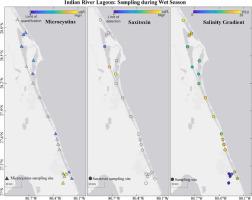Harmful Algae ( IF 6.6 ) Pub Date : 2021-03-21 , DOI: 10.1016/j.hal.2021.102012 Abdiel E. Laureano-Rosario , Malcolm McFarland , David J. Bradshaw , Jackie Metz , Rachel A. Brewton , Tara Pitts , Carlie Perricone , Stephanie Schreiber , Nicole Stockley , Guojun Wang , Esther A. Guzmán , Brian E. Lapointe , Amy E. Wright , Charles A. Jacoby , Michael S. Twardowski

|
Harmful algal blooms that can produce toxins are common in the Indian River Lagoon (IRL), which covers ~250 km of Florida's east coast. The current study assessed the dynamics of microcystins and saxitoxin in six segments of the IRL: Banana River Lagoon (BRL), Mosquito Lagoon (ML), Northern IRL (NIRL), Central IRL (CIRL), Southern IRL (SIRL), and the St. Lucie Estuary (SLE). Surface water samples (n = 40) collected during the 2018 wet and 2019 dry season were analyzed to determine associations between toxins and temperature, salinity, pH, oxygen saturation, concentrations of dissolved nutrients and chlorophyll-a, presence of biosynthetic genes for toxins, relative abundance of planktonic species, and composition of the microbial community. The potential toxicity of samples was assessed using multiple mammalian cell lines. Enzyme-Linked Immunosorbent Assays were used to determine concentrations of microcystins and saxitoxin. Overall, the microcystins concentration ranged between 0.01-85.70 µg/L, and saxitoxin concentrations ranged between 0.01-2.43 µg/L across the IRL. Microcystins concentrations were 65% below the limit of quantification (0.05 µg/L), and saxitoxin concentrations were 85% below the limit of detection (0.02 µg/L). Microcystins concentrations were higher in the SLE, while saxitoxin was elevated in the NIRL and BRL. Cytotoxicity related to the presence of microcystins was seen in the SLE during the wet season. No significant patterns between cytotoxicity and saxitoxin were identified. Dissolved nutrients were identified as the most highly related parameters, explaining 53% of microcystin and 47% of saxitoxin variability. Multivariate models suggested cyanobacteria, flagellates, ciliates, and diatoms as the subset of microorganisms whose abundances were maximally correlated with saxitoxin and microcystins concentrations. Lastly, biosynthetic genes for microcystins were detected in the SLE and for saxitoxin in the BRL and NIRL. These results highlight the synergistic roles environmental and biological parameters play in influencing the dynamics of toxin production by harmful algae in the IRL.
中文翻译:

佛罗里达印第安河泻湖中微囊藻毒素和毒毒素的动态
可能产生毒素的有害藻华在印度河泻湖(IRL)中很常见,该河占佛罗里达州东海岸约250公里。目前的研究评估了IRL六部分中微囊藻毒素和毒素的动态:香蕉河泻湖(BRL),蚊子泻湖(ML),北部IRL(NIRL),中部IRL(CIRL),南部IRL(SIRL)和圣露西河口(SLE)。地表水样本(n = 40)在2018年潮湿和2019年干燥季节收集的毒素进行了分析,以确定毒素与温度,盐度,pH,氧饱和度,溶解的营养素和叶绿素-a的浓度,毒素的生物合成基因的存在,浮游生物的相对丰富度之间的关联,以及微生物群落的组成。使用多种哺乳动物细胞系评估了样品的潜在毒性。酶联免疫吸附试验用于确定微囊藻毒素和毒素的浓度。总体而言,整个IRL的微囊藻毒素浓度范围为0.01-85.70 µg / L,毒毒素的浓度范围为0.01-2.43 µg / L。微囊藻毒素的浓度比定量下限(0.05 µg / L)低65%,而毒素的浓度比检测极限(0.02 µg / L)低85%。SLE中的微囊藻毒素浓度较高,而NIRL和BRL中的沙毒素较高。在雨季期间,在SLE中观察到与微囊藻毒素存在有关的细胞毒性。在细胞毒性和毒毒素之间没有发现明显的模式。溶解的养分被确定为最相关的参数,解释了53%的微囊藻毒素和47%的毒素毒素变异性。多元模型表明,蓝细菌,鞭毛,纤毛和硅藻是微生物的子集,其丰度与毒素和微囊藻毒素的浓度最大相关。最后,在SLE中检测到了微囊藻毒素的生物合成基因,在BRL和NIRL中检测到了沙毒素的生物合成基因。



























 京公网安备 11010802027423号
京公网安备 11010802027423号